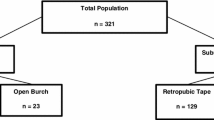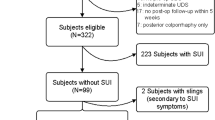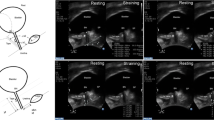Abstract
This study aims to identify variables associated with successful voiding before hospital discharge in women undergoing urinary stress incontinence (USI) surgery. Medical records of women who underwent USI surgery between July 1997 and October 2005 were reviewed. Demographic, urodynamic, and perioperative data were recorded. The primary outcome was successful voiding at hospital discharge. Univariate, bivariate, and logistic regression analyses were performed (SPSS 12.0/SPSS, Chicago, IL, USA). The two groups, successful vs unsuccessful voiders, were similar in age, postmenopausal status, and prior hysterectomy/incontinence/prolapse surgery. Burch colposuspension was performed in 82% and pubovaginal sling in 18% of women. Multivariate logistic regression analysis revealed that age < 45 years (OR 2.6), sustained detrusor contraction (OR 4.4), and Burch colposuspension (OR 2.9) were positively associated with early successful voiding. Early successful voiding was associated with age < 45 years, sustained detrusor contraction, and Burch colposuspension. These data may facilitate preoperative counseling in women undergoing USI surgery.
Similar content being viewed by others
References
Al-Hayek S, Abrams P (2004) Women’s lower urinary tract function and dysfunction: definitions and epidemiology. Minerva Ginecol 56(4):311–325
Hunskaar S, Vinsnes A (1991) The quality of life in women with urinary incontinence as measured by the sickness impact profile. J Am Geriatr Soc 39(4):378–382
van der Vaart CH, De Leeuw JRJ, Roovers JPWR, Heintz APM (2002) The effect of urinary incontinence and overactive bladder symptoms on quality of life in young women. BJU Int 90(6):544–549
Leach GE, Dmochowski RR, Appell RA, Blaivas JG, Hadley HR, Luber KM, Mostwin JL, O’Donnell PD, Roehrborn CG (1997) Female Stress Urinary Incontinence Clinical Guidelines Panel summary report on surgical management of female stress urinary incontinence. The American Urological Association. J Urol 158(3 Pt 1):875–880
Fantl JA, Newman DK, Colling J, et al. (1996) Managing Acute and Chronic Urinary Incontinence. Clinical Practice Guideline. Quick Reference Guide for Clinicians, No. 2, 1996 Update. Rockville, MD: U.S. Department of Health and Human Services, Public Health Service, Agency for Health Care Policy and Research. AHCPR Pub. No. 96-0686
Walters MD, Karam MM (1999) Urogynecology and Reconstructive Pelvic Surgery, 2ndnd edn. Mosby, St. Louis, MO
Eriksen BC, Hagen B, Eik-Nes SH, Molne K, Mjolnerod OK, Romsio L (1990) Long-term effectiveness of the Burch colposuspension in female urinary stress incontinence. Acta Obstet Gynecol Scand 69:45–50
Korda A, Ferry J, Hunter P (1989) Colposuspension for the treatment of female urinary incontinence. Aust N Z J Obstet Gynaecol 29:146–149
Young SB, Rosenblatt PL, Pingeton DM, Howard AE, Baker SP (1995) The Mersilene mesh suburethral sling: a clinical and urodynamic evaluation. Am J Obstet Gynecol 173:1719–1726
Ghoniem GM, Shaaban A (1994) Sub-urethral slings for the treatment of stress urinary incontinence. Int Urogynecol J 5:228–239
Nygaard IE, Kreder KJ (1994) Complications of incontinence surgery. Int Urogynecol J 5:353–360
Al-Badr A, Ross S, Soroka D, Minassian VA, Karahalios A, Drutz HP (2003) Voiding patterns and urodynamics after tension-free vaginal tape procedure. J Obstet Gynaecol Can 25:725–730
Kleeman S, Goldwasser S, Vassallo B, Karram M (2002) Predicting postoperative voiding efficiency after operation for incontinence and prolapse. Am J Obstet Gynecol 187:49–52
Barron KI, Savageau JA, Young SB Labin LC, Morse AN (2006) Prediction of successful voiding immediately after outpatient mid-urethal sling. Int Urogynecol J Pelvic Floor Dysfunct 17(6):570–575
Kobak WH, Walters MD, Piedmonte MR (2001) Determinants of voiding after three types of incontinence surgery: a multivariable analysis. Obstet Gynecol 97:86–91
Minassian VA, Al-Badr A, Drutz HP, Lovatsis D (2004) Tension-free vaginal tape, Burch, and slings: are there predictors for early postoperative voiding dysfunction. Int Urogynecol J 15:183–187
Bergman A, Bhatia NN (1985) Uroflowmetry for predicting postoperative voiding difficulties in women with stress urinary incontinence. Br J Obstet Gynaecol 92(8):835–838
Miller EA, Amundsen CL, Toh KL, Flynn BJ, Webster GD (2003) Preoperative urodynamic evaluation may predict voiding dysfunction in women undergoing pubovaginal sling. J Urol 169(6):2234–2237
Weinberger MW, Ostergard DR (1996) Postoperative catheterization, urinary retention, and permanent voiding dysfunction after polytetrafluoroethylene suburethral sling placement. Obstet Gynecol 87(1):50–54
Boyles SH, Weber AM, Meyn L (2003) Procedures for urinary incontinence in the United States, 1979–1997. Am J Obstet Gynecol 189:70–75
McLennan MT, Melick CF, Bent AE (1998) Clinical and urodynamic predict tors of delayed voiding after fascia lata suburethral sling. Obstet Gynecol 92(4 Pt 1):608–612
Conflicts of interest
None.
Author information
Authors and Affiliations
Corresponding author
Rights and permissions
About this article
Cite this article
Oliphant, S., Amburgey, Ö.A. & Connolly, A. Predictors of successful voiding before hospital discharge after urinary stress incontinence surgery. Int Urogynecol J 19, 805–810 (2008). https://doi.org/10.1007/s00192-007-0532-4
Received:
Accepted:
Published:
Issue Date:
DOI: https://doi.org/10.1007/s00192-007-0532-4




